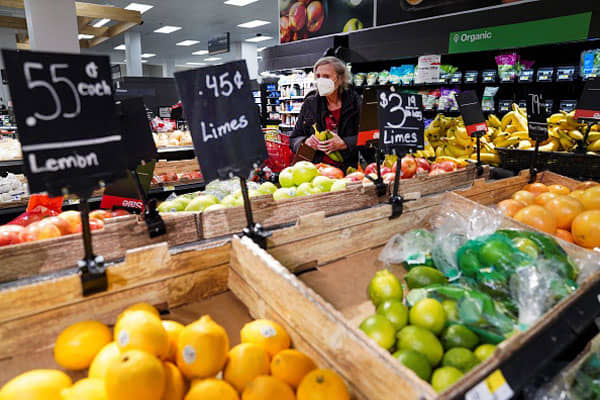
Consumer prices surged more than expected over the past 12 months, indicating a worsening outlook for inflation and cementing the likelihood of substantial interest rate hikes this year.
The consumer price index for January, which measures the costs of dozens of everyday consumer goods, rose 7.5% compared to a year ago, the Labor Department reported Thursday.
That compared to Dow Jones estimates of 7.2% for the closely watched inflation gauge. It was the highest reading since February 1982.
Stripping out volatile gas and grocery costs, the CPI increased 6%, compared to the estimate of 5.9%. Core inflation rose at its fastest level since August 1982.
The monthly CPI rates also came in hotter than expected, with headline and core CPI both rising 0.6%, compared to the estimates for a 0.4% increase on both measures.
Stock market futures declined following the report, with rate-sensitive tech stocks hit especially hard. Government bond yields rose sharply, with the benchmark 10-year Treasury note touching 2%, its highest since August 2019.
Markets also got more aggressive in pricing rate hikes ahead.
The chances of a 0.5 percentage point Fed rate hike in March rose to 44.3% following the data release, compared to 25% just before, according to CME data. Chances of a sixth quarter-percentage-point hike increased to about 63%, compared to about 53% before the release.
“With another surprise jump in inflation in January, markets continue to be concerned about an aggressive Fed,” said Barry Gilbert, LPL Financial asset allocation strategist. “While things may start getting better from here, market anxiety about potential Fed overtightening won’t go away until there are clear signs inflation is coming under control.”
Food, shelter costs up sharply
The inflation numbers come at a crossroads for the U.S. economy, with 2021’s rapid growth pace expected to slow this year as fiscal and monetary stimulus fades. Growth is still expected to be above-trend, though sharper rate increases from an inflation-fighting Fed could prove troublesome.
On a percentage basis, fuel oil rose the most in January, surging 9.5% as part of a 46.5% year-over-year increase. Energy costs overall were up 0.9% for the month and 27% on the year.
Vehicle costs, which have been one of the biggest inflation contributors since it began surging higher in the spring of 2021, were flat for new models and up 1.5% for used cars and trucks in January. The two categories have posted respective increases of 12.2% and 40.5% over the past 12 months.
Shelter costs, which make up about one-third of the total CPI number, increased 0.3% on the month, which is the smallest gain since August 2021 and slightly below December’s increase. Still, the category is up 4.4% over the past year and could keep inflation readings elevated in the future.
Food costs jumped 0.9% for the month and are up 7% over the past year.
That combination of higher food and housing prices “underlines our view that a rapid cyclical acceleration in inflation is underway and, with labor market conditions exceptionally tight, it is unlikely to abate any time soon,” wrote Andrew Hunter, senior U.S. economist at Capital Economics.
“While we still expect more favorable base effects and a partial easing of supply shortages to push core inflation lower this year, this suggests it will remain well above the Fed’s target for some time,” he added.
The burst in inflation has muted the sizeable earnings growth workers have seen. Real average hourly earnings rose just 0.1% for the month, as the 0.7% monthly gain in wages was almost completely wiped out by the 0.6% inflation gain.
A separate report Thursday showed that weekly jobless claims totaled 223,000 for the week ended Feb. 5, a decline of 16,000 from the previous week and below the 230,000 estimate. It was the lowest total since Jan. 1.
Continuing claims, which run a week behind, held at 1.62 million. The total of those receiving benefits under all programs rose slightly to about 2.1 million, according to Labor Department data through Jan. 22.




